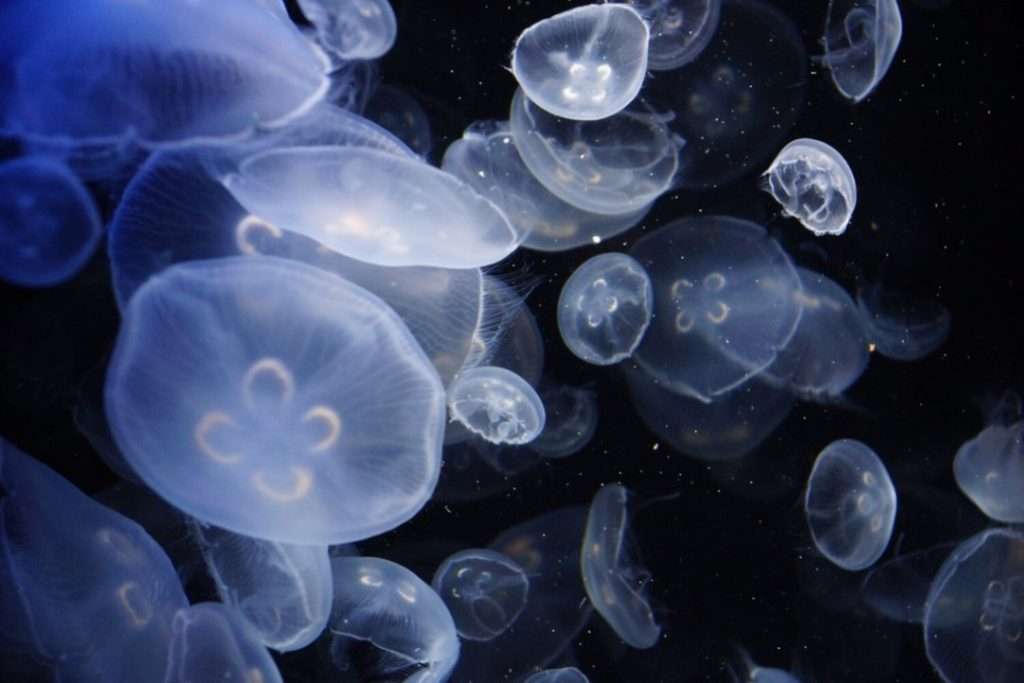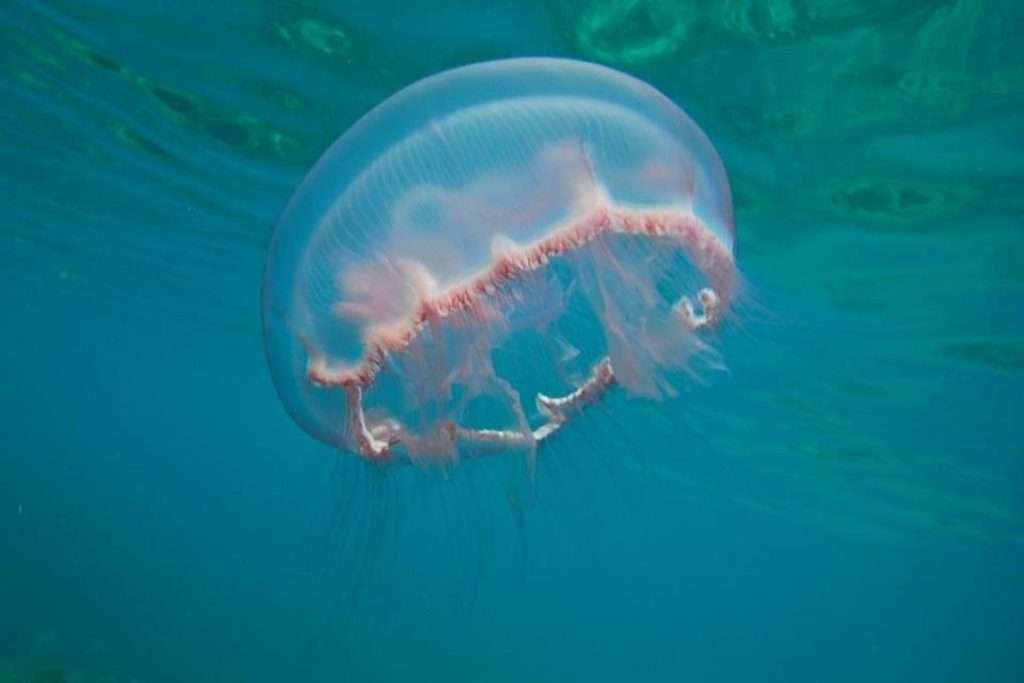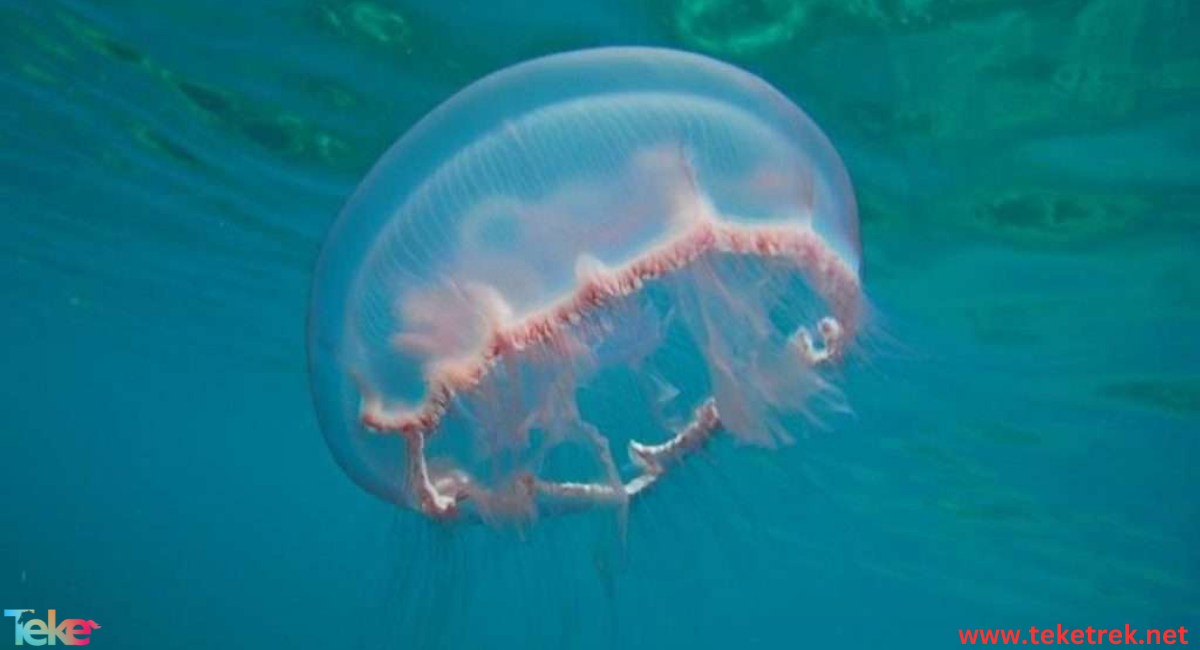The moon jellyfish is one of the most distinctive creatures in the modern era, as it is included in multiple research studies.
We talk below on the teketrek website in more detail about this creature, what are its characteristics, behaviors, and food.

About the moon jellyfish
Moon Jelly is one of the most famous types of jellyfish, and it is a marine animal.
- It has a clear main body, with 4 purple-white circles positioned above the bell.
- It has a white disc shape, with short claws, and its reproductive glands are prominent.
- It is affectionately called the cnidarian moon jelly. It has rather short claws hanging from the sides.
- It has ring-shaped muscles that contract and water push out of the bell.
- Jellyfish are able to move efficiently due to their ability to form vortices on the edge of their bell that allow for increased propulsion.
- Contracting the bell requires muscle force, as the expansion occurs automatically due to the fact that the tissue is elastic and returns to its original shape.
Components of the moon jellyfish body
The body of the moon jellyfish is made up of water, which constitutes 98% of its body. It lacks a heart, bones, or brain, but it contains primitive sensory nerves at the base of the tentacles that help it distinguish smells, see light, and determine its direction. It consists of:
- Epidermis is an outer layer that protects internal organs.
- The gastrodermis is the inner layer of the body.
- Mesoglea has a gelatinous consistency and is located between the epidermis and the gastrodermis.
- The gastrovascular cavity functions as the esophagus, stomach, and intestines.
- The orifice performs the function of both the mouth and the anus.
- Tentacles surround the edges of an organism’s body.
Moon jellyfish habitats
- You’ll find moon jellyfish in tropical to temperate regions of the North Atlantic Ocean, including along the coast or even in open water.
- Jellyfish are not strong swimmers, so you may see them washing up on the beach after a strong storm.

The life cycle of a moon jellyfish
The life cycle of a moon jellyfish consists of the following stages:
- The adult male deposits sperm from his mouth.
- While some females lay their eggs on their arms. After that, the eggs are fertilized by the sperm during swimming.
- As for the rest of the other species, they keep the eggs in their mouths, swallow the sperm, and fertilization takes place in their stomachs. Then the eggs are released to attach to the female’s arms.
- After that, the eggs hatch and give rise to larvae. They float, and if they escape predatory organisms, they settle to the bottom and turn into polyps.
- After that, the larvae attach themselves to any object and form new polyps from their stem. Years later, the larvae move to a new stage.
- The organisms begin to form horizontal, fleshy growths, until they form a small moon jellyfish.
Food for the moon jellyfish
The moon jellyfish is a carnivore, as it:
- Small moon jellyfish eat microorganisms, for example: plants, small fish and fish eggs.
- Whereas the large jellyfish feeds on large organisms, for example: shrimp, crabs, plants, crabs, and other jellyfish surrounding it.
- His digestive system is simple, but he can eat a variety of foods.
Interesting facts about moon jellyfish
Among the most prominent facts about the moon jellyfish:
- The moon jellyfish is aware of its position through optical stimuli and a balance organ, and it has ways of correcting itself when shifting in the ocean current.
- Researchers have proven that the moon jellyfish uses one neural network for forward swimming and two for rotational movements.
- Neurons move around the bell in a wave-like pattern, and they can move even when large parts of the bell are affected.
- The moon jellyfish picks up the signals and then transmits them to its bell. When one nerve cell fires, the other fires as well.
- Moon jellyfish are a favorite food source for ocean predators such as sunfish, sea turtles.
- The moon jellyfish is one of the newest animals in which neural networks are being studied.
- It provides a natural environment for answers to new questions about neural networks, artificial intelligence, and robotics.
- Beachgoers fear moon jellyfish because of their powerful stings, but moon jellyfish actually do not sting humans.


FAQ
The most common questions about the moon jellyfish:
- When does a jellyfish sting dangerous?
If you experience tightness or wheezing in While breathing, you should go to the emergency room.
- What is the most dangerous jellyfish in the world?
The Portuguese Man of War jellyfish is considered one of the most dangerous jellyfish in the world.
- What to do if you are stung by a jellyfish?
They cause immediate pain, skin infections, and some other diseases that affect the whole body but are rarely life-threatening.
- How long do jellyfish live?
The moon jellyfish would exist for a period ranging from 300 to 505 million years.
- Is it permissible to eat jellyfish?
Jellyfish are considered suitable for human consumption.


In short, the moon jellyfish is a marine animal that inhabits the tropics and is used in modern-day artificial intelligence studies.






